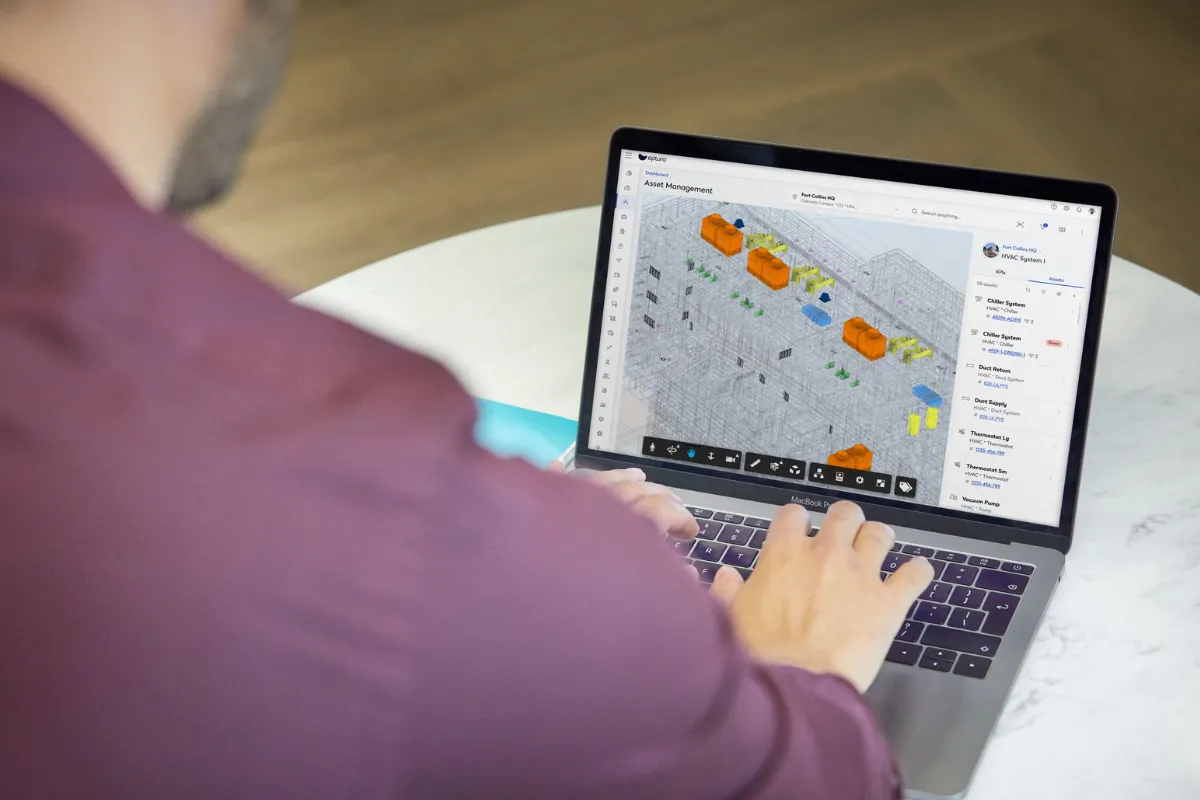
In today’s highly competitive financial services sector, institutions are under constant pressure to streamline operations, reduce risk, and drive long-term value across every facet of the business — including their physical workplaces. As the role of facilities management becomes increasingly strategic, one technology is rapidly emerging as a game-changer: digital twins. By creating dynamic, data-rich virtual replicas of buildings and infrastructure, digital twins empower facilities and asset managers with real-time insights, predictive capabilities, and operational foresight. For large financial franchises, this shift isn’t just about smarter maintenance, it’s about unlocking new levels of efficiency, cost control, and sustainability in a rapidly evolving environment.
The emergence of digital twins in facility management
A digital twin is a virtual model that accurately reflects a physical object, system, or process. In the context of facility management, this means creating a digital counterpart of a building’s infrastructure, encompassing structural elements, HVAC systems, electrical networks, and more. By leveraging data from Internet of Things (IoT) sensors and advanced analytics, digital twins provide a comprehensive, real-time view of facility operations.
The global market for digital twins has been experiencing significant growth. According to Fortune Business Insights, the market size was valued at USD 17.73 billion in 2024 and is projected to grow from USD 24.48 billion in 2025 to USD 259.32 billion by 2032, exhibiting a compound annual growth rate (CAGR) of 40.1% during the forecast period. This surge underscores the increasing recognition of digital twins’ value across various sectors, including financial services.
Driving factors for adoption in financial institutions
Several compelling factors are prompting financial institutions to integrate digital twins into their facility management strategies:
- Operational efficiency and cost optimization: Digital twins facilitate real-time monitoring and analysis of building systems, enabling facilities managers to identify inefficiencies and optimize performance. For instance, by analyzing energy consumption patterns, managers can implement measures to reduce waste and lower utility costs. Hexagon reports that implementing digital twins can improve operational and maintenance efficiency by 35%, streamlining building management processes.
- Predictive maintenance: Traditional maintenance approaches often rely on scheduled inspections or reactive responses to equipment failures, which can lead to unexpected downtime and increased costs. Digital twins enable predictive maintenance by continuously monitoring the condition of assets and forecasting potential failures before they occur. This proactive approach not only extends the lifespan of equipment but also reduces maintenance expenses. According to AECbytes, digital twins are transforming asset management by enabling real-time monitoring, predictive capabilities, and smarter decision-making.
- Enhanced risk management: Financial institutions are inherently risk-averse, and managing physical assets is no exception. Digital twins provide a detailed understanding of a facility’s infrastructure, allowing managers to simulate various scenarios and assess potential risks. This capability is invaluable in preparing for emergencies, ensuring compliance with safety regulations, and safeguarding both personnel and assets.
- Sustainability initiatives: With growing emphasis on environmental responsibility, financial institutions are seeking ways to reduce their carbon footprint. Digital twins contribute to sustainability efforts by enabling precise monitoring and control of energy usage, facilitating the implementation of energy-saving measures. Hexagon notes that digital twins can reduce a building’s carbon emissions by 50%, significantly enhancing sustainability efforts.
Benefits of implementing digital twin technologies
The practical benefits of digital twins are evident in various implementations within the financial sector:
- Space utilization optimization: By analyzing occupancy data, facilities managers can make informed decisions about space allocation, leading to more efficient use of office areas and potential reductions in real estate costs. Hexagon’s blog discusses how combining a 3D digital twin with web-based facilities management software increases transparency and productivity while reducing costs.
- Energy management: Digital twins enable detailed tracking of energy consumption across different building systems. This information allows for targeted interventions to reduce energy usage, contributing to cost savings and environmental goals.
- Emergency preparedness: In the event of an emergency, digital twins provide real-time data on building occupancy and system statuses, aiding in effective response planning and execution. Matterport illustrates that digital twins support better emergency planning by simulating drills so staff stays ready for anything.
In episode 133 of Eptura’s Asset Champion podcast, host Mike Petrusky spoke with Kimon Onuma, President of ONUMA, Inc. And Cyril Verley, President and CEO of CDV Systems, Inc., about how digital twins can help streamline organizational outcomes. They agreed that digital twins and BIM provide a framework for achieving this.
Digital twin technology is a foundation, but it’s not the starting point. First, companies need to identify the use case.
“The primary driver should be ‘What is the use case?’ From a facility perspective, what are you trying to achieve?” explained Onuma.
Digital twins act as maps, added Verlay, and the best people to create maps are the architects, engineers, and contractors.
“It seems to me that the key of managing a facility from an owner’s perspective is a map. I mean, if they can have access to a map of some kind and locate a room, locate an asset and whatever information is on their iPad or their iPhone[…] using a handheld device with a map, I think that’s really the center of what a digital twin should be.”
Implementing digital twins: Considerations for financial institutions
While the advantages are clear, successful implementation of digital twins requires careful planning:
- Integration with existing systems: Ensuring compatibility between digital twin technology and current facility management systems is crucial for seamless operation.
- Data security and privacy: Given the sensitive nature of financial institutions, robust measures must be in place to protect data integrity and confidentiality.
- Investment in skills and training: Equipping staff with the necessary skills to operate and interpret digital twin systems is essential for maximizing their potential.
As software development company Endava explains in their article about the potential of digital twins in financial services, the technology could be a major pivot in reducing asset downtime. They explain that “downtime can be catastrophic in banking, leading to millions in lost revenue, diminished customer trust and the potential for regulatory breaches. Digital twins can enable predictive maintenance to ensure that banks can identify vulnerabilities and stay ahead of operational risks before they become crises. This could be anticipating hardware failure in ATMs or pre-empting software glitches; digital twins could allow for the move from reactive to proactive risk management.”
Banks can simulate regulatory compliance scenarios to ensure their systems remain current with the latest financial laws and regulations. For instance, banks preparing for changes like the MIFID III framework can test their systems to assess readiness, which helps mitigate compliance risks and avoid potential fines.
Digital twins in action: How UCHealth boosted operational efficiency and reduced costs
UCHealth had been facing significant challenges managing its extensive portfolio of facilities, including inefficient space utilization and maintenance management, which led to increased operational costs and made effective patient care more difficult.
To address these challenges, UCHealth implemented solutions from Autodesk and Archibus. They wanted better facility management through better data integration and real-time analytics. The program started by creating detailed 3D models of facilities with Autodesk Revit, which helped in accurate space planning and management. The next step was implementing Archibus to streamline maintenance operations by automating workflows and providing comprehensive asset management tools.
UCHealth has reported significant improvements in operational efficiency, including reduced maintenance costs and better allocation of space, directly contributing to enhanced patient care and staff satisfaction. Implementing Autodesk and Archibus has also provided UCHealth with valuable data-driven insights, allowing for proactive facility management and strategic decision-making.
To do a deeper dive into how Eptura’s Archibus and strategic partner, Archibus, propelled UCHealth forward, you can read the full customer story here.
Looking ahead: The future of digital twins in financial services
As financial institutions navigate a complex operational landscape — balancing efficiency, compliance, sustainability, and cost control — digital twins are fast becoming an essential tool in the facilities management toolkit. Far more than a futuristic concept, they offer a practical, data-driven approach to managing large, intricate real estate portfolios with greater agility and insight. For facilities and asset managers tasked with overseeing critical infrastructure across global financial franchises, digital twins represent not just a technological upgrade, but a strategic evolution. By embracing this innovation today, institutions position themselves to lead tomorrow, transforming their workplaces into intelligent, adaptive environments that support both business performance and long-term resilience.
Find out how your financial institution could benefit from incorporating digital twins into your existing facilities management strategy by getting in touch with Eptura.




